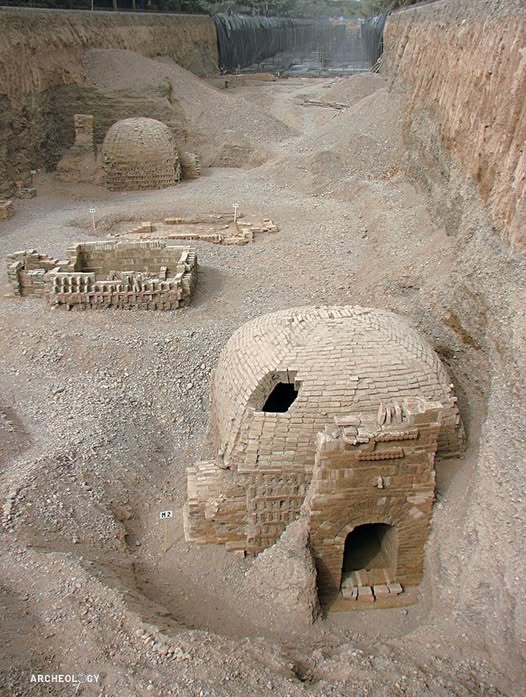
Unearthed in the ancient city of Ur, located in modern-day Iraq, these vaulted brick tombs are extraordinary relics from the Early Bronze Age, dating back to approximately 2500 BCE. Ur, a major Sumerian urban center, was a cradle of early civilization, and its royal cemeteries stand as a testament to the wealth, sophistication, and cultural achievements of the Sumerians. The tombs serve as monumental resting places for the elite royalty, high priests, and influential individuals—ensuring their journey into the afterlife was marked with the same grandeur they had experienced in life.
Sophisticated Architecture and Engineering
The design of these tombs reveals a high level of architectural sophistication and understanding of engineering principles. The tombs feature vaulted brick structures, with carefully constructed dome-like chambers made of meticulously laid bricks. This use of arches and curved brickwork was a significant innovation for the time, showcasing early advancements in building techniques. The construction was not only aimed at ensuring the tombs’ durability but also at providing a secure and protected space for the deceased, reflecting the Sumerians’ reverence for life and the afterlife.
The curved design of the brickwork forms robust, dome-shaped enclosures, which have remarkably withstood millennia beneath layers of earth and debris. The precision and skill involved in crafting these tombs underscore the technological advancements of the Sumerians, demonstrating an early understanding of architectural principles that would influence later civilizations.
A Window into the Past
Excavations of the tombs in Ur have revealed much more than just physical graves they offer a glimpse into the cultural values, social hierarchies, and spiritual beliefs of one of the world’s earliest urban societies. The tombs were not simply places of burial but represented the status and legacy of the individuals they housed. They were designed to reflect the deceased’s position in society, both in life and in death. For the Sumerians, the tomb was as important as the life it honored, intended to protect the body and ensure the individual’s immortality in the eyes of their gods and society.
Surrounding the excavation site is stratified soil that tells a rich and layered story of Ur’s history. Each layer of soil contains the remnants of a once-thriving metropolis, offering archaeological insights into the lives of the people who lived and worked there. From the grandeur of the royal burials to the daily lives of the commoners, the layers of Ur’s history are still embedded in the earth, waiting to be uncovered.
Symbolism of Immortality and Legacy
More than just ancient graves, these tombs embody the timeless human desire for immortality and remembrance. The Sumerians believed that one’s legacy could be preserved through monumental acts of architecture, and the elaborate tombs at Ur reflect this belief. In many ways, these tombs were a sacred investment in eternity, intended to ensure that the names of those buried within would never be forgotten.
They also reflect the spiritual and religious beliefs of the Sumerians, who viewed death as a continuation of the soul’s journey. These tombs were seen not merely as final resting places but as gateways to the afterlife, where the deceased would continue to influence the world of the living. By honoring the deceased with such elaborate burial sites, the Sumerians sought to secure the favor of the gods, ensuring protection for the dead and prosperity for the living.
A Lasting Legacy
The vaulted tombs of Ur stand as lasting symbols of the Sumerian civilization, offering us a direct connection to the earliest narratives of life, death, and legacy. They reveal the Sumerians’ devotion to their elite rulers, their sophisticated understanding of architecture, and their complex belief systems. Today, these structures provide valuable insight into the spiritual and cultural framework that shaped one of the most influential civilizations in human history.
In their silent solidity, these tombs not only connect us to the past but also remind us of the fundamental human desire to be remembered, to leave something enduring behind. As we continue to uncover and study these ancient monuments, they offer us a window into the heart of Sumerian culture and a deeper understanding of the human quest for immortality.
Leave a Reply